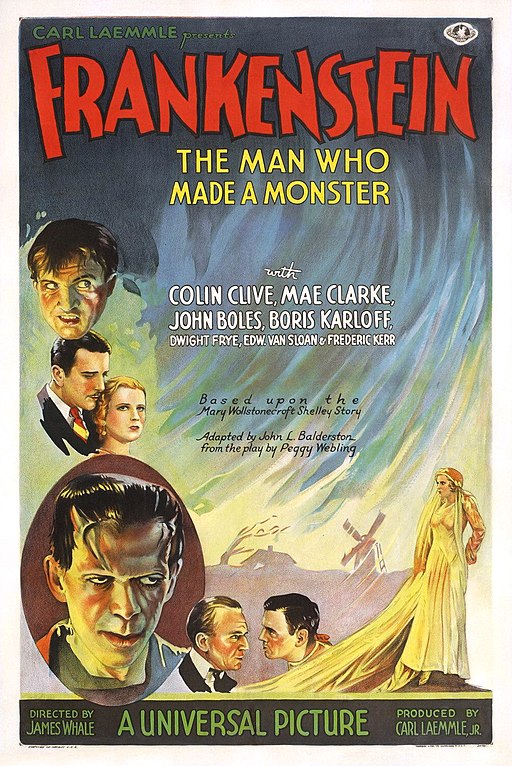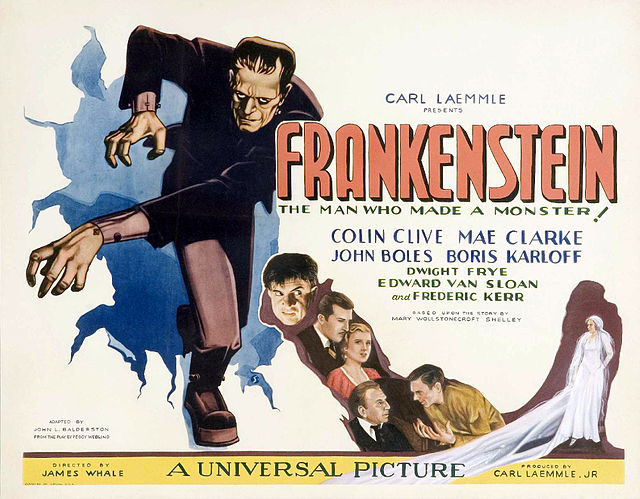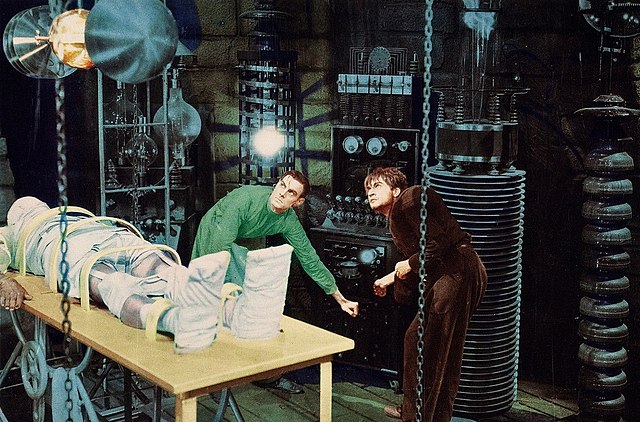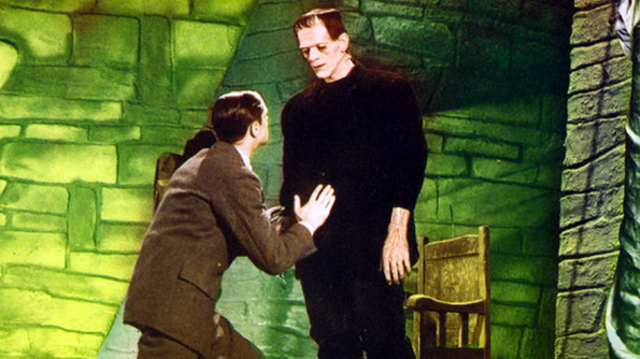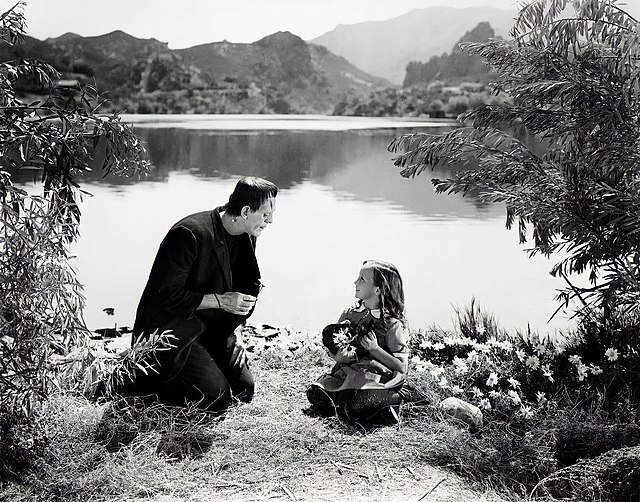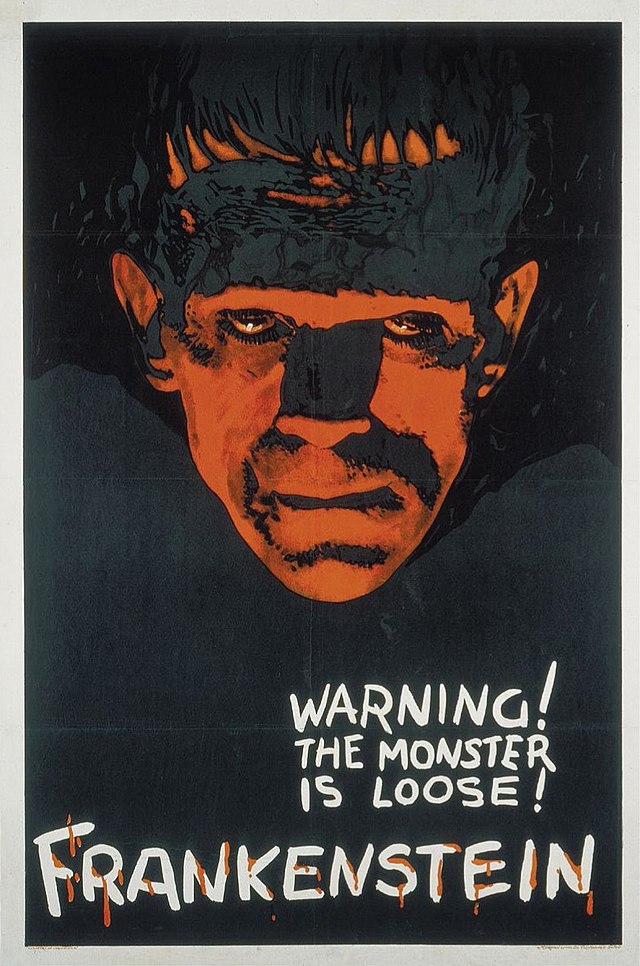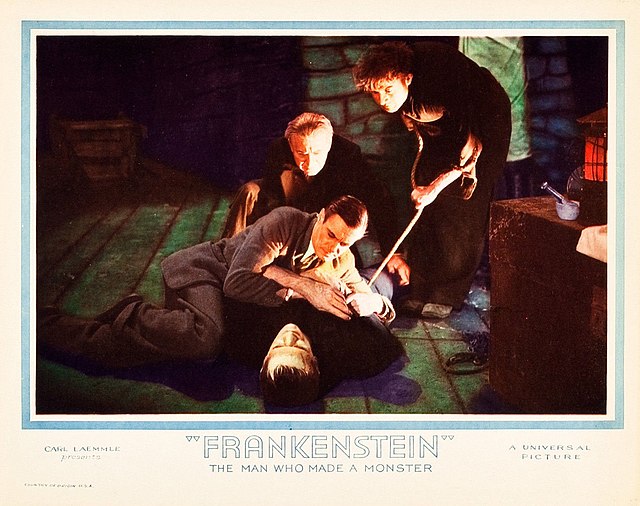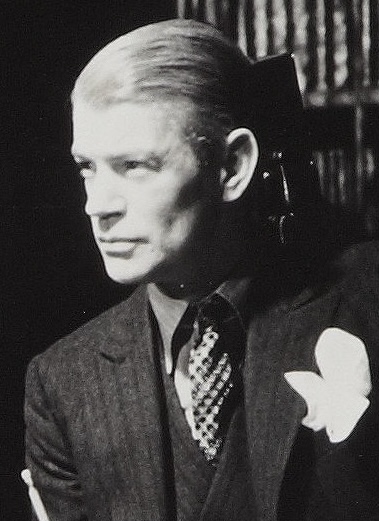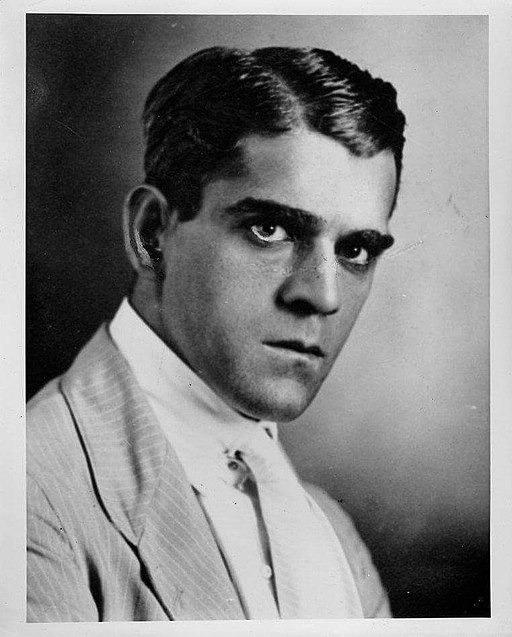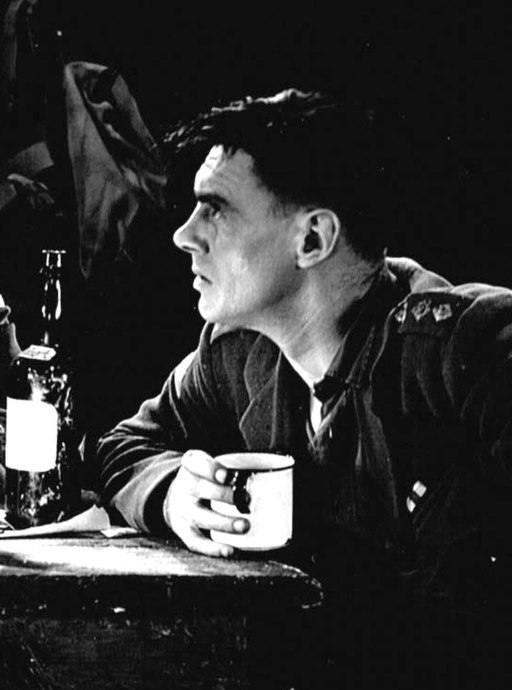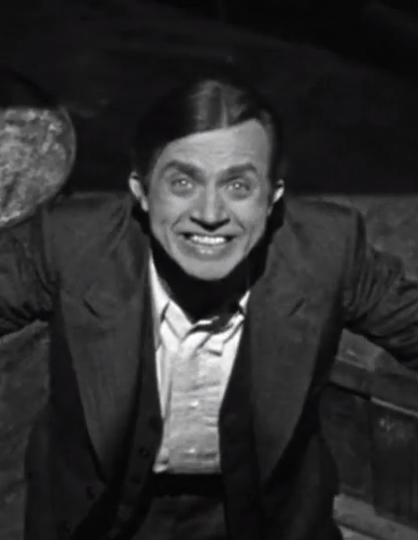Frankenstein - 1931
back| Released by | Universal Pictures |
| Director | James Whale |
| Producer | Carl Laemmle Jr. |
| Script | Adapted by Garrett Fort and Francis Edward Faragoh, based on the play by Peggy Webling and the novel by Mary Shelley |
| Cinematography | Arthur Edeson |
| Music by | Composed by Bernhard Kaun |
| Running time | 70 minutes |
| Film budget | $262,000 |
| Box office sales | $12 million |
| Main cast | Colin Clive - Boris Karloff - Mae Clarke - Dwight Frye - John Boles - Edward Van Sloan |
Frankenstein
The Groundbreaking Classic Horror Movie
"Frankenstein" (1931), directed by James Whale, is a seminal horror film that follows Dr. Henry Frankenstein (Colin Clive) as he brings a Monster (Boris Karloff) to life using electricity.
The film's innovative special effects, atmospheric direction, and Karloff's sympathetic portrayal of the Monster made it a critical and commercial success, influencing the horror genre and popular culture significantly.
Related
Frankenstein – 1931
Summary and Analysis
"Frankenstein" opens with a forewarning to the audience about the horrifying and shocking events they are about to witness. The story begins in a small Bavarian village, where young scientist Henry Frankenstein (Colin Clive) is obsessed with discovering the secret to creating life. He becomes so consumed with his experiments that he isolates himself from his fiancée Elizabeth (Mae Clarke) and friends, including his best friend Victor Moritz (John Boles).
Henry, aided by his hunchbacked assistant Fritz (Dwight Frye), conducts experiments in a secluded, dilapidated watchtower. The pair collect body parts from graves and recently executed criminals, assembling them into a human form. Henry’s goal is to imbue this creature with life, defying natural laws and playing God.
The tension builds as Henry's mentor, Dr. Waldman (Edward Van Sloan), along with Elizabeth and Victor, arrive at the tower to confront Henry about his unorthodox experiments. Despite their pleas, Henry is determined to succeed. On a stormy night, using electricity harnessed from lightning, Henry brings his creation to life. The creature, played by Boris Karloff and referred to as "The Monster," awakens. Initially, Henry is ecstatic about his success, exclaiming, "It's alive! It's alive!"
The Monster, however, is not the abomination Henry expected. Though initially docile and childlike, the Monster becomes increasingly violent due to mistreatment and fear. Fritz torments the Monster with a torch, causing it to lash out and eventually kill Fritz. Henry and Waldman sedate the Monster and plan to destroy it, but Henry, exhausted and mentally strained, collapses.
Henry returns home to prepare for his wedding to Elizabeth, leaving Waldman to dismantle the creature. However, the Monster awakens, kills Waldman, and escapes into the countryside. The Monster encounters a young girl named Maria (Marilyn Harris) and, in a tragic misunderstanding, accidentally drowns her while playing a game by the lake.
The villagers are soon alerted to the Monster's presence after Maria's body is discovered. A mob forms, led by the grief-stricken father, and they march to Frankenstein's estate. The Monster kidnaps Elizabeth on her wedding day, leading to a climactic confrontation in an old windmill.
In the final scenes, Henry chases the Monster to the windmill. After a fierce struggle, the Monster throws Henry from the top of the windmill. The villagers set the windmill ablaze, trapping the Monster inside. The film ends with Henry recovering from his injuries, surrounded by loved ones, while the fate of the Monster is left ambiguous amidst the burning wreckage.
Analysis:
"Frankenstein" (1931) is a landmark film in the horror genre and one of the most influential movies of its time. Directed by James Whale, it combines elements of Gothic horror, science fiction, and drama to explore themes of creation, responsibility, and the consequences of playing God.
Themes:
- Creation and Responsibility: The film delves into the ethical implications of scientific experimentation. Henry Frankenstein’s quest to create life raises questions about the responsibilities that come with such power. His failure to foresee the consequences of his actions and to care for his creation leads to tragedy, highlighting the potential dangers of unchecked scientific ambition.
- Isolation and Loneliness: Both Henry and the Monster experience profound isolation. Henry isolates himself from society and his loved ones in his obsessive pursuit of scientific discovery. The Monster, abandoned by its creator and feared by society, embodies the consequences of neglect and the innate human need for connection.
- Nature vs. Nurture: The Monster’s transformation from innocent to violent reflects the nature vs. nurture debate. Initially, the creature is gentle, but repeated mistreatment and rejection by humans drive it to violence. This suggests that the Monster’s brutality is not inherent but a response to its harsh environment and experiences.
Cinematic Techniques:
- Expressionist Influence: Whale’s direction shows a strong influence of German Expressionism, particularly in the use of stark lighting, dramatic shadows, and angular set designs. This creates an eerie and oppressive atmosphere that heightens the film’s horror elements.
- Makeup and Special Effects: Jack Pierce’s makeup for Boris Karloff’s Monster is iconic, creating a memorable and sympathetic character despite its grotesque appearance. The special effects, particularly the use of electrical equipment and laboratory sets, were groundbreaking for their time and added to the film’s sense of wonder and terror.
- Performances: Colin Clive’s portrayal of Henry Frankenstein captures the character’s obsessive zeal and eventual despair. Boris Karloff’s performance as the Monster is deeply affecting, conveying a range of emotions through body language and facial expressions, despite minimal dialogue.
Cultural Impact:
"Frankenstein" has had a lasting impact on popular culture and the horror genre. The image of the Monster, with its flat head, bolts in the neck, and lumbering gait, has become a cultural icon. The film has inspired numerous adaptations, sequels, and reinterpretations, cementing its place in cinematic history.
In conclusion, "Frankenstein" (1931) is a masterful exploration of human ambition and its potential consequences. Through its compelling narrative, innovative visual style, and memorable performances, the film continues to resonate with audiences and provoke thoughtful reflection on the limits of scientific inquiry and the responsibilities of creation.
Classic Trailer Frankenstein 1931:
Full Cast of Frankenstein:
· Colin Clive as Henry Frankenstein
· Mae Clarke as Elizabeth
· John Boles as Victor Moritz
· Boris Karloff as The Monster
· Edward Van Sloan as Dr. Waldman
· Frederick Kerr as Baron Frankenstein
· Dwight Frye as Fritz
· Lionel Belmore as Herr Vogel, Burgomaster
· Marilyn Harris as Maria
· Michael Mark as Ludwig, Maria's father
· Ted Billings as Villager (uncredited)
· Mae Bruce as Villager (uncredited)
· Jack Curtis as Villager (uncredited)
· William Dyer as Gravedigger (uncredited)
· Francis Ford as Hans, Ludwig's friend (uncredited)
· Soledad Jiménez as Maria's mother (uncredited)
· Sessel Anne Johnson as Little Girl (uncredited)
· Margaret Mann as Mourner (uncredited)
· Pauline Moore as Mourner (uncredited)
· Cecilia Parker as Maid (uncredited)
· Rose Plumer as Mourner (uncredited)
· Cecil Reynolds as Medical Examiner (uncredited)
· Ellinor Vanderveer as Mourner (uncredited)
Analysis of James Whale's Direction in "Frankenstein" (1931)
James Whale's direction of "Frankenstein" in 1931 is widely regarded as a masterclass in early horror cinema, showcasing his unique ability to blend atmospheric tension, emotional depth, and innovative visual storytelling. Here is a detailed analysis of Whale's direction:
Visual Style and Atmosphere
- Expressionist Influence: Whale's direction was heavily influenced by German Expressionism, a movement characterized by stark contrasts, angular shadows, and distorted sets. This influence is evident in the film's use of lighting and set design, creating an eerie, nightmarish world that reflects the inner turmoil of the characters. The laboratory scenes, with their looming machinery and stark shadows, exemplify this style, adding to the film's sense of dread and otherworldliness.
- Innovative Cinematography: Working with cinematographer Arthur Edeson, Whale utilized creative camera angles and movements to heighten the suspense and horror. For instance, the iconic scene where the Monster comes to life is filmed from a low angle, emphasizing the power and menace of the creature. The use of close-ups, particularly of Boris Karloff’s expressive face, helps convey the Monster’s complex emotions, eliciting both fear and sympathy from the audience.
Character Development and Performances
- Sympathetic Monster: One of Whale’s most significant contributions to "Frankenstein" is his portrayal of the Monster as a sympathetic character. Rather than depicting the creature solely as a mindless villain, Whale focuses on its innocence and confusion, which evoke a sense of tragedy. Karloff’s nuanced performance, guided by Whale’s direction, ensures that the Monster is seen as a victim of circumstance and scientific hubris, rather than a mere antagonist.
- Strong Supporting Cast: Whale’s direction brought out memorable performances from the entire cast. Colin Clive’s portrayal of Henry Frankenstein captures the character’s obsessive brilliance and eventual descent into despair. Mae Clarke as Elizabeth brings a sense of warmth and concern, grounding the film’s emotional core. Dwight Frye’s performance as Fritz adds an element of grotesque comic relief, balancing the film’s darker themes.
Narrative Pacing and Structure
- Tight Pacing: Whale’s storytelling is marked by its tight pacing, ensuring that the film maintains tension throughout its 70-minute runtime. He skillfully balances moments of intense horror with quieter, more reflective scenes, allowing the audience to become fully immersed in the story. The gradual build-up to the Monster’s creation, followed by the escalating chaos, keeps viewers engaged from start to finish.
- Thematic Depth: Under Whale’s direction, "Frankenstein" explores complex themes such as the dangers of unchecked ambition, the ethical limits of science, and the consequences of playing God. Whale does not shy away from these heavy themes, but instead weaves them seamlessly into the narrative, prompting audiences to reflect on the moral implications of Henry Frankenstein’s actions.
Use of Sound and Music
- Atmospheric Sound Design: Although "Frankenstein" lacks a traditional musical score, Whale makes effective use of sound to enhance the film’s atmosphere. The sounds of the laboratory equipment, the crackling of electricity, and the Monster’s guttural noises all contribute to the film’s immersive experience. Whale’s judicious use of silence also amplifies the tension, allowing the audience to feel the weight of the moment.
- Minimalist Music: The minimal use of music, composed by Bernhard Kaun, adds to the film's unsettling atmosphere. When music is present, it is used sparingly to underscore key moments, such as the dramatic sequences in the laboratory. This minimalist approach ensures that the audience remains focused on the visual and narrative elements of the film.
Legacy and Influence
- Iconic Imagery: Whale’s direction has left an indelible mark on the horror genre. The image of the Monster, with its flat head and bolts, has become a cultural icon. The film’s visual style and thematic depth have influenced countless subsequent works, solidifying Whale’s place as a pioneer of horror cinema.
- Critical Acclaim: Over the years, "Frankenstein" has been lauded for its artistic and technical achievements. Whale’s direction is often cited as a key factor in the film’s enduring appeal, with critics praising his ability to blend horror with humanity. The film’s success paved the way for future horror directors, establishing many of the conventions that continue to define the genre.
Iconic Performance of Boris Karloff:
Boris Karloff's portrayal of the Monster in James Whale's "Frankenstein" is a cornerstone of cinematic history, and his performance remains one of the most iconic in the horror genre. Here is a detailed analysis of Karloff's performance, highlighting the nuances and impact of his portrayal:
Physicality and Presence
- Transformative Makeup: The transformative makeup by Jack Pierce was crucial in shaping the Monster’s iconic look, but it was Karloff's ability to embody this creature that brought it to life. The heavy makeup and prosthetics could have easily restricted his performance, yet Karloff used them to enhance the character's otherworldly appearance. The flat head, sunken eyes, and neck bolts created a visage that was both terrifying and pitiable.
- Body Language: Karloff’s physical performance is perhaps the most striking aspect of his portrayal. His deliberate, lumbering gait and the way he carried himself conveyed the Monster's immense physical power and childlike vulnerability. Every movement seemed calculated to emphasize the character's tragic struggle with its own existence. Karloff’s ability to communicate the Monster's emotions through body language alone was remarkable, especially considering the limited use of dialogue.
- Facial Expressions: Despite the restrictive makeup, Karloff used subtle facial expressions to convey a wide range of emotions, from confusion and fear to anger and sadness. The Monster’s initial moments of life, marked by its tentative, almost innocent exploration of its surroundings, are rendered poignantly through Karloff’s nuanced expressions. His ability to evoke sympathy for the Monster was a key factor in making the character more than just a terrifying figure.
Emotional Depth and Humanity
- Innocence and Curiosity: Karloff imbued the Monster with a sense of innocence and curiosity that made its eventual descent into violence all the more tragic. The scene where the Monster encounters Maria, the young girl by the lake, is a perfect example. The Monster's gentle interaction with her, followed by the tragic misunderstanding that leads to her death, highlights the creature’s intrinsic desire for companionship and its tragic inability to understand its own strength.
- Pathos and Tragedy: Karloff’s performance captures the inherent tragedy of the Monster’s existence. Created from dead body parts and brought to life through unnatural means, the Monster is abandoned by its creator and rejected by society. Karloff’s portrayal elicits deep empathy, as viewers can see the pain and confusion in the Monster’s eyes. This emotional depth elevates the character from a mere horror movie antagonist to a tragic figure akin to classic literary creations.
- Transformation and Rage: As the Monster faces continuous abuse and rejection, Karloff effectively transitions from portraying a gentle, misunderstood being to a creature filled with rage and despair. This transformation is gradual and believable, driven by the character’s experiences rather than an inherent evil. The scene where the Monster kills Fritz, the assistant who torments it with a torch, is both horrifying and understandable, illustrating the creature's breaking point.
Impact and Legacy
- Cultural Icon: Karloff’s portrayal of the Monster has become an indelible part of popular culture. The character's design and Karloff's performance have influenced countless adaptations and homages in film, television, and literature. The image of Karloff as the Monster is instantly recognizable and continues to be associated with the broader mythos of Frankenstein.
- Sympathetic Villain: Karloff's ability to infuse the Monster with such humanity and pathos transformed the archetype of the movie monster. Rather than being a simple figure of horror, the Monster is a sympathetic character whose plight resonates with audiences. This nuanced portrayal has inspired future generations of actors to bring depth and complexity to their roles in the horror genre.
- Career Defining Role: For Karloff, the role of the Monster was career-defining. It established him as a leading figure in horror cinema and led to a series of memorable roles in other classic horror films. Despite the challenge of acting under heavy makeup and with limited dialogue, Karloff’s performance in "Frankenstein" demonstrated his exceptional talent and versatility as an actor.
In conclusion, Boris Karloff's performance as the Monster in "Frankenstein" is a masterclass in physical acting and emotional depth. His ability to convey the character's inner turmoil and humanity, despite the limitations imposed by the makeup and the silent, expressive approach, created a portrayal that remains deeply affecting and influential. Karloff's Monster is not just a figure of fear but a tragic, empathetic character whose story continues to resonate with audiences nearly a century after the film's release.
Memorable Movie Quotes from Frankenstein:
· Henry Frankenstein: "It's alive! It's alive! In the name of God, now I know what it feels like to be God!"
· Henry Frankenstein: "Look! It's moving. It's alive. It's alive... It's alive, it's moving, it's alive, it's alive, it's alive, it's alive, IT'S ALIVE!"
· Dr. Waldman: "You have created a monster, and it will destroy you!"
· Henry Frankenstein: "One man crazy—three very sane spectators."
· The Monster: "Friend? Friend?"
· Elizabeth: "The whole village is up in arms. They're coming to burn the monster. We must run."
· Henry Frankenstein: "Dangerous? Poor old Waldman. Have you never wanted to do anything that was dangerous? Where should we be if nobody tried to find out what lies beyond? Have you never wanted to look beyond the clouds and the stars, or to know what causes the trees to bud? And what changes the darkness into light? But if you talk like that people call you crazy. Well, if I could discover just one of these things—what eternity is, for example—I wouldn't care if they did think I was crazy."
· Baron Frankenstein: "Well, as I said before, here I say again, 'Here I say.'"
Recognition for the Movie:
Despite not receiving major awards at the time of its release, "Frankenstein" (1931) has garnered significant recognition and acclaim over the years, solidifying its place in cinematic history. Here's an overview of the recognition the film has received:
Critical Acclaim and Legacy
- Influence on the Horror Genre: "Frankenstein" is considered one of the most influential horror films ever made. Its themes, visual style, and character portrayals have set a benchmark for the genre. The film's success led Universal Pictures to produce a series of horror films, establishing the studio as a leader in the genre during the 1930s and 1940s.
- Iconic Performances: Boris Karloff’s portrayal of the Monster has become iconic, transforming him into a horror legend. His performance is often cited as one of the greatest in the history of the genre. The film also established Colin Clive’s portrayal of Henry Frankenstein as the quintessential mad scientist.
- Cultural Impact: The film's imagery, particularly the Monster's makeup and appearance, has become deeply embedded in popular culture. The flat-headed Monster with neck bolts remains one of the most recognizable figures in horror.
Preservation and Honors
- National Film Registry: In 1991, "Frankenstein" was selected for preservation in the United States National Film Registry by the Library of Congress. This honor is given to films that are considered "culturally, historically, or aesthetically significant".
- Critical Rankings: The film frequently appears on lists of the greatest films ever made. It is praised for its pioneering special effects, atmosphere, and the profound performance of Boris Karloff. It is included in the American Film Institute’s list of the 100 greatest American films.
- Film Festivals and Retrospectives: "Frankenstein" has been featured in numerous film festivals and retrospectives celebrating classic cinema. These events often highlight the film’s innovation in special effects and its influence on later horror films.
- Academic Study: The film is a subject of extensive academic study and analysis. It is frequently discussed in the context of film studies, particularly for its exploration of themes such as the dangers of unchecked ambition and the ethical implications of scientific discovery.
Popularity and Enduring Appeal
- Box Office Success: Upon its release, "Frankenstein" was a commercial success, significantly boosting Universal Pictures' fortunes. Its success helped establish the horror genre as a viable and profitable area for film studios.
- Home Media and Re-releases: The film has been re-released multiple times and remains popular on home media platforms. Its availability on various formats has ensured that it continues to reach new audiences.
- Merchandise and Adaptations: The film has inspired a wide range of merchandise, including toys, posters, and Halloween costumes. It has also spawned numerous adaptations, including sequels, remakes, and reinterpretations across different media.
Classic Scenes from Frankenstein:
The Creation Scene
Description: The creation scene is perhaps the most iconic moment in "Frankenstein." It takes place in Henry Frankenstein's laboratory, where he uses the power of a thunderstorm to bring the Monster to life. As the body is hoisted toward the opening in the roof, lightning strikes, and the machinery buzzes with energy. Henry, played by Colin Clive, is ecstatic as he exclaims, "It's alive! It's alive! In the name of God, now I know what it feels like to be God!"
Significance:
- Visual and Technical Achievement: This scene showcases the film's groundbreaking special effects and set design, which were revolutionary for the time. The use of lightning and electrical equipment creates a dramatic and memorable atmosphere.
- Thematic Depth: Henry's exclamation highlights the film's central themes of playing God and the hubris of scientific ambition. It sets the stage for the moral and ethical dilemmas explored throughout the film.
- Cultural Impact: The scene has been referenced and parodied countless times in popular culture, cementing its place in cinematic history .
The Monster's First Appearance
Description: The Monster, played by Boris Karloff, makes his first full appearance in a memorable sequence. The camera initially shows him from behind, and as he turns to face the camera, the audience sees his face for the first time. The camera zooms in on his expressionless, scarred visage, creating a powerful and unsettling moment.
Significance:
- Character Introduction: This scene effectively introduces the Monster, establishing him as both terrifying and pitiable. Karloff's performance, combined with the makeup by Jack Pierce, leaves a lasting impression.
- Cinematic Techniques: The use of close-up shots and the slow reveal build suspense and create a sense of dread. This approach has influenced the way monsters and villains are introduced in horror films.
- Emotional Impact: The Monster's expression and body language convey his confusion and vulnerability, eliciting sympathy from the audience despite his grotesque appearance.
The Scene with Maria
Description: In one of the film's most poignant and tragic scenes, the Monster encounters a young girl named Maria. They begin to play by a lake, throwing flowers into the water to see them float. When the Monster runs out of flowers, he throws Maria into the lake, not understanding that she cannot float like the flowers. She drowns, leading to a tragic and heartbreaking moment.
Significance:
- Pathos and Tragedy: This scene underscores the Monster's innocence and lack of understanding. His actions are not malicious but stem from a childlike innocence. It evokes deep sympathy for the creature.
- Moral and Ethical Questions: The scene raises questions about responsibility and the consequences of Henry's actions. It highlights the Monster's need for guidance and compassion, which he never receives.
- Cinematic Impact: The juxtaposition of innocence and tragedy in this scene has been highly influential in horror cinema. It showcases the potential for horror films to evoke complex emotions beyond fear.
The Windmill Finale
Description: The film's climax takes place in an old windmill, where the Monster takes refuge after being pursued by an angry mob. Henry Frankenstein follows, and a confrontation ensues. The mob sets the windmill on fire, trapping the Monster inside. The windmill collapses in flames, leading to a dramatic and intense conclusion.
Significance:
- Dramatic Conclusion: The windmill scene provides a thrilling and visually spectacular finale. The use of fire and the collapsing structure create a sense of chaos and finality.
- Symbolism: The destruction of the windmill can be seen as symbolic of the destructive consequences of Henry's hubris and the tragic fate of the Monster. It reinforces the themes of creation and destruction that run throughout the film.
- Legacy: This scene has been widely imitated and referenced in subsequent horror films and adaptations of the Frankenstein story. It remains one of the most memorable and impactful conclusions in horror cinema.

